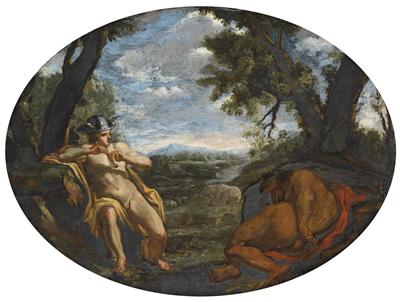Pier Francesco Mola

(Coldrerio 1612–1666 Rome)
Mercury and Argus in a landscape,
oil on slate, oval, 31 x 41.5 cm, framed
Provenance:
European private collection
Literature:
C. Benocci, “Mercurio e Argo: una nuova attribuzione a Pier Francesco Mola”, in: Strenna dei Romanisti, 71.2010, pp. 61-72;
F. Petrucci, Pier Francesco Mola (1612–1666). Materia e colore nella pittura del ‘600, Rome 2012, cat. no. B25, p. 292
The present painting is a recent addition to the oeuvre of Pier Francesco Mola and is from his early period. First published by Carla Benocci (see literature), it has been included in the catalogue raisonné of the artist by Francesco Petrucci (see literature).
According to Benocci and Petrucci the painting can be dated to 1640-1645. During the years 1633–1640 and 1641–1647 Mola travelled widely in northern Italy; he may have been in Bologna in the studio of Francesco Albani between 1638-1640 and in Venice in 1644. The present work, together with other small cabinet paintings by the artist, displays the result of his contact with Venetian and Bolognese painting. The landscape setting and the figures are influenced by the Bolognese classicism of the Carracci school: in particular, the figure of Mercury is based on the Polifemo painted by Annibale Carracci in the Farnese Gallery in Rome.
Mola painted others works of the same subject, that can be compared to the present painting. The landscape in the canvas, today on loan at the City Museum and Art Gallery of Birmingham (from the collection of Sir Denis Mahon), dated by Richard Cocke to the same period (1640-1645), is similar to that of the present painting, though the figures are different (see R. Cocke, Pier Francesco Mola Oxford, 1972, n° 16). The composition is also comparable to Mercury and Argus in Berlin, Staatliche Museen (oil on canvs, 61x54 cm), where the landscape is more elaborated (see R. Cocke, cit., n.°2). The closest composition can be seen in an etching by Mola where the two figures are similarly placed in “contrapposto” (Londra, British Museum, inv. N. 1874-8-8-813).
According to Petrucci, the use of slate as a support is “a rare evidence of Mola’s inclination to adopt, as well as canvas, supports as copper, slate, marble or panel”. Painting on slate was first introduced in Rome by Sebastiano del Piombo, and was widely used in the 17th century, particularly by genre painters and for small exquisite cabinet painting. The gleaming dark background was especially well suited to nocturnal scenes or, as in the present painting, to experimental chiaroscuro effects.
17.04.2013 - 18:00
- Estimate:
-
EUR 15,000.- to EUR 20,000.-
Pier Francesco Mola
(Coldrerio 1612–1666 Rome)
Mercury and Argus in a landscape,
oil on slate, oval, 31 x 41.5 cm, framed
Provenance:
European private collection
Literature:
C. Benocci, “Mercurio e Argo: una nuova attribuzione a Pier Francesco Mola”, in: Strenna dei Romanisti, 71.2010, pp. 61-72;
F. Petrucci, Pier Francesco Mola (1612–1666). Materia e colore nella pittura del ‘600, Rome 2012, cat. no. B25, p. 292
The present painting is a recent addition to the oeuvre of Pier Francesco Mola and is from his early period. First published by Carla Benocci (see literature), it has been included in the catalogue raisonné of the artist by Francesco Petrucci (see literature).
According to Benocci and Petrucci the painting can be dated to 1640-1645. During the years 1633–1640 and 1641–1647 Mola travelled widely in northern Italy; he may have been in Bologna in the studio of Francesco Albani between 1638-1640 and in Venice in 1644. The present work, together with other small cabinet paintings by the artist, displays the result of his contact with Venetian and Bolognese painting. The landscape setting and the figures are influenced by the Bolognese classicism of the Carracci school: in particular, the figure of Mercury is based on the Polifemo painted by Annibale Carracci in the Farnese Gallery in Rome.
Mola painted others works of the same subject, that can be compared to the present painting. The landscape in the canvas, today on loan at the City Museum and Art Gallery of Birmingham (from the collection of Sir Denis Mahon), dated by Richard Cocke to the same period (1640-1645), is similar to that of the present painting, though the figures are different (see R. Cocke, Pier Francesco Mola Oxford, 1972, n° 16). The composition is also comparable to Mercury and Argus in Berlin, Staatliche Museen (oil on canvs, 61x54 cm), where the landscape is more elaborated (see R. Cocke, cit., n.°2). The closest composition can be seen in an etching by Mola where the two figures are similarly placed in “contrapposto” (Londra, British Museum, inv. N. 1874-8-8-813).
According to Petrucci, the use of slate as a support is “a rare evidence of Mola’s inclination to adopt, as well as canvas, supports as copper, slate, marble or panel”. Painting on slate was first introduced in Rome by Sebastiano del Piombo, and was widely used in the 17th century, particularly by genre painters and for small exquisite cabinet painting. The gleaming dark background was especially well suited to nocturnal scenes or, as in the present painting, to experimental chiaroscuro effects.
|
Buyers hotline
Mon.-Fri.: 10.00am - 5.00pm
old.masters@dorotheum.at +43 1 515 60 403 |
| Auction: | Old Master Paintings |
| Auction type: | Saleroom auction |
| Date: | 17.04.2013 - 18:00 |
| Location: | Vienna | Palais Dorotheum |
| Exhibition: | 06.04. - 17.04.2013 |
